Complete Solutions to EXERCISES of chapter REFRACTION AT SPHERICAL SURFACES of Class 12 book with complete answers and questions
| Class 12 | PHYSICS |
| Chapter | REFRACTION AT SPHERICAL SURFACES |
| CP SINGH | EXERCISES |
| Number Of Questions | 100 |
| Academic Year | 2023-24 |
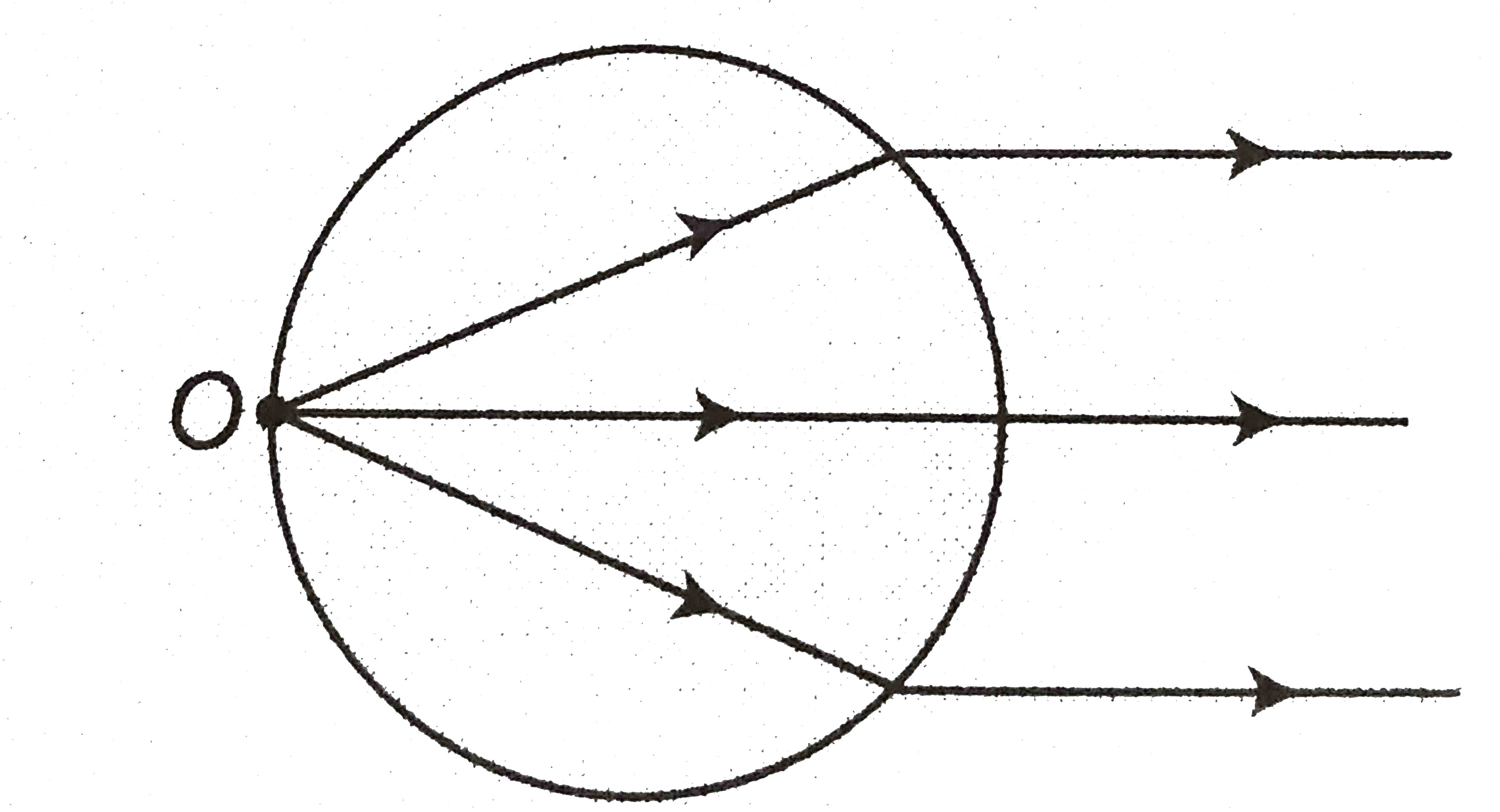
An object `O` is stuck on the surface of a transparent solid spher of radius 20 cm. Find refractive index of the sphere such that rays from the object after refraction from the opposite side emerge as a parallel beam, as shown Also prove that refractive index has the same value in the given situation for any value of radius of sphere.04:26View SolutionA poinit object `O` is placed in front of a glass rod having spherical end of radius of curvature `30cm`. The image would be formed at
 03:39View Solution
03:39View Solution
A point object `O` is kept at a distance `OP=u` The radius of curvature of the spherical surface APB is `CP=R` The refractive index of the media are `n_1` and `n_2` which are as shown in the diagram . Then,
(A) if `n_1gtn_2`, image is virtual for all values of u
(B) if `n_2=2n_1` image is virtual when `Rgtu`
(C) The image is real for all values of `u`, `n_1` and `n_2` here, the correct statements is/are03:30View SolutionA spherical surface of radius of curvature R separates air (refractive index 1.0) from glass (refractive index 1.5). The centre of curvature is in the glass. A point object P placed in air is found to have a real image Q in the glass. The line PQ cuts the surface at a point O, and `PO=OQ`. The distance `PO`
03:26View SolutionFigure shows figure three transparent medi of refractive indices `mu_1, mu_2 and mu_3`. A point object O is placed in the medium `mu_2`. If the entire medium on the right of the spherical surface has refractive index `mu_1`, the image forms at O. If this entire medium has refractive index `mu_2` the image form at O''. In the situation shown
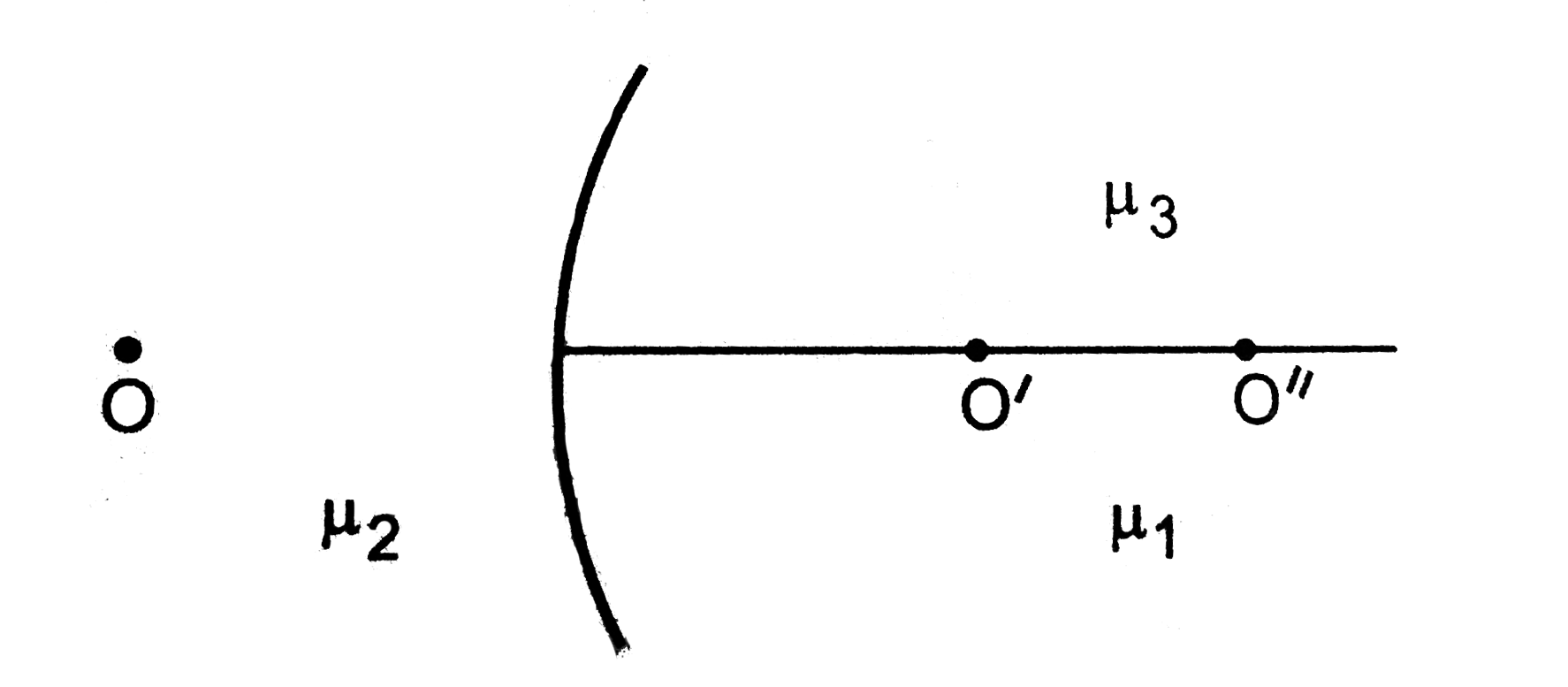 07:16View Solution
07:16View SolutionA glass hemisphere of radius 0.04 m and refractive index of the material 1.6 is placed centrally over cross mark on a paper (i) with the flat face, (ii) with the curved face in contact with the paper. In each case, the cross mark is viewed directly from above. The position of the images will be
06:51View SolutionA small air bubble in a glass sphere of radius `2 cm` appears to be `1 cm` from the surface when looked at, along a diameter. If the refractive index of glass is `1.5`, find the true position of the air bubble.
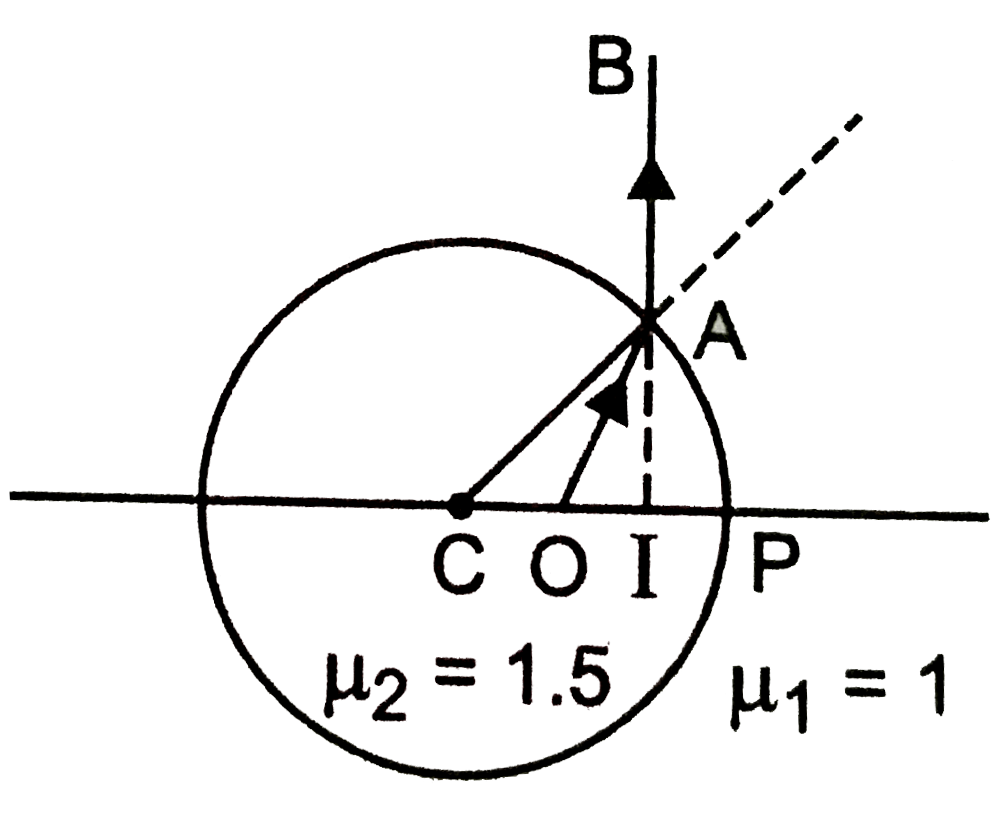 .03:51View Solution
.03:51View SolutionA ray of light falls on the surface of a spherical glass paper weight making an angle `alpha` with the normal and is refracted in the medium at an angle `beta`. The angle of deviation of the emergent ray from the direction of the incident ray is :
02:58View SolutionFocal length of a convex lense in air is `10cm`. Find its focal
length in water. Given that `mu_g=3//2` and `mu_w=4//3`.03:47View SolutionThe radius of curvature of the convex surface of a thin plano-convex lens is 15 cm and the refractive index of its material is 1.6. The power of the lens is
02:05View SolutionA convex lens of glass has power P in air. If it is immersed in water its power will be
02:37View SolutionA concave lens of glass, refractive index 1.5 has both surfaces of same radius of curvature R. On immersion in a medium of refractive index 1.75, it will behave as a
04:15View SolutionIn figure, an air lens of radius of curvature of each surface equal to `10 cm` is cut into a cylinder of glass of refractive index `1.5.` The focal length and the nature of lens are
 01:01View Solution
01:01View SolutionA thin convergent glass lens `(mu_g=1.5)` has a power of `+5.0D.` When this lens is immersed in a liquid of refractive index `mu_1,` it acts as a divergent lens of focal length `100 cm.` The value of `mu_1` is
03:26View SolutionA hollow double concave lens is made of very thin transparent material. It can be filled with air or either of two liquids L_1 or L_2 having refractive indices mu_1 and mu_2 respectively `(mu_2gtmu_1gt1)`. The lens will deverge a parallel beam of light if it is filled with
03:20View SolutionThe ray diagram could be correct
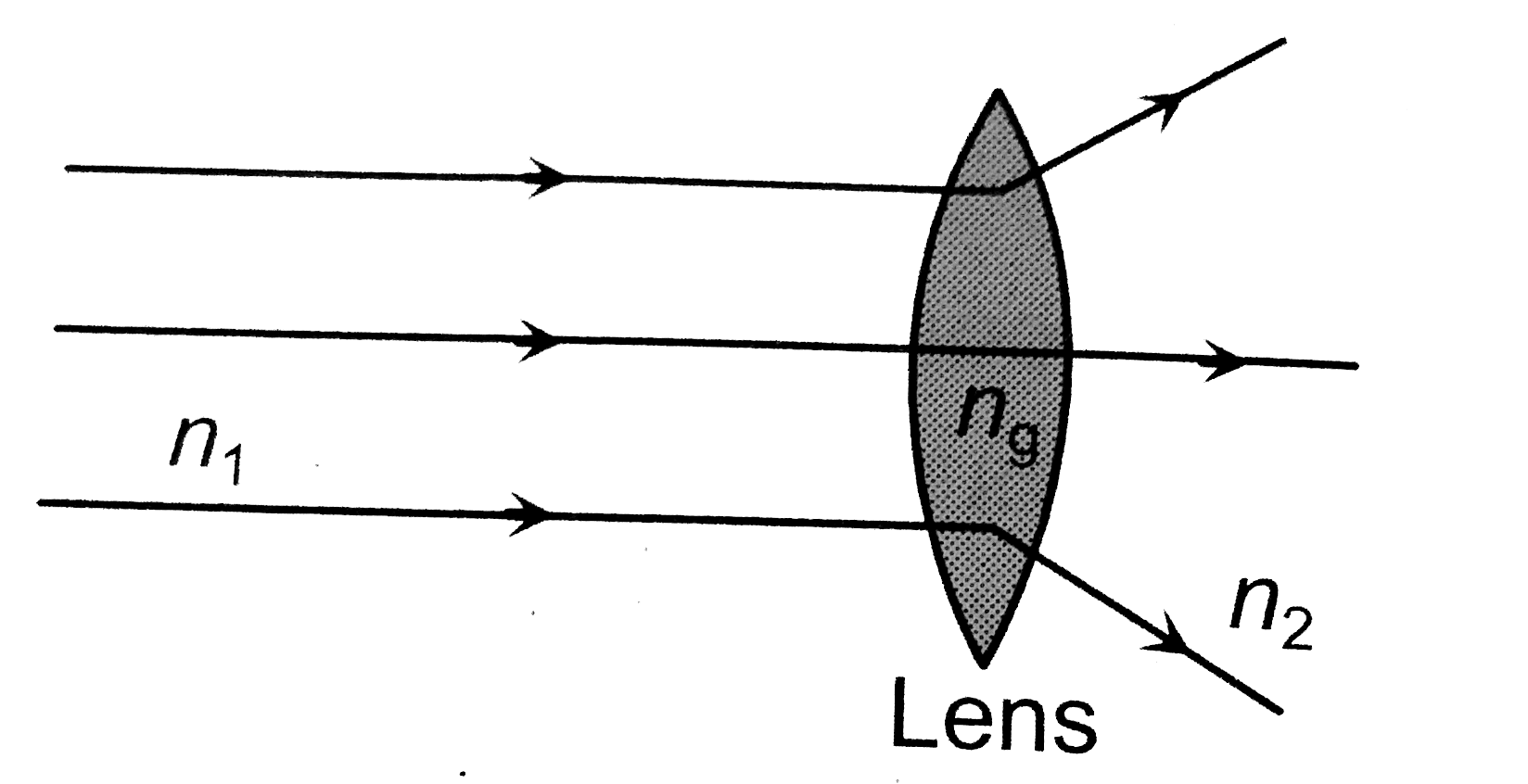 02:47View Solution
02:47View SolutionA lens of refractive index n is put in a liquid of refractive index `n'`. If focal length of lens in air is `f`, its focal length in liquid will be.
02:55View SolutionA convex lens is dipped in a liquid whose refractive index is equal to the refractive of the lens. Then its focal length will
03:03View SolutionFour lenses are made from the same type of glass, the radius of curvature of each face is given below. Which will have the greatest positive power
03:33View SolutionAn equi-convex glass lens with radius of each face as R is placed in air `(._au_g=3//2)`. "If there is water in the object space and air in the image space and given" `._au_w=4//3`, the focal length of the lens is
04:53View SolutionIn the above question if there is air in the object space and water in the image space, then the focal length is
04:53View Solution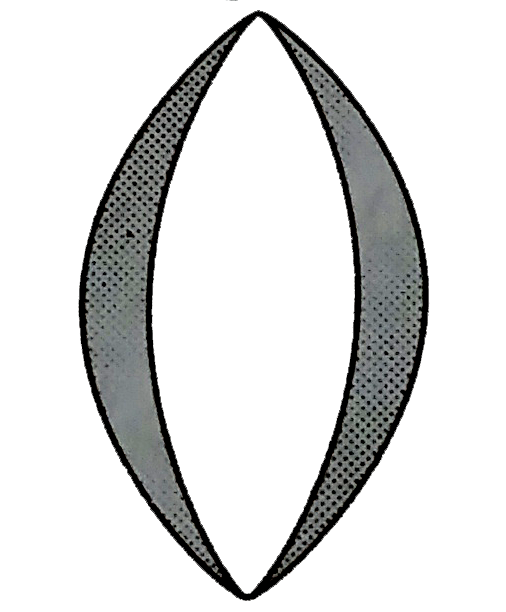
A convex lens is made of 3 layers of glass of 3 different materials as in the figure. A point object is placed on its axis. The number of images of the object are01:54View SolutionThe focal length for violet, green and red light rays are `f_V,f_G` and `f_R` respectively. Which fo the following is the true relationship?
02:15View SolutionAn equiconvex lens is cut into two halves along `(i) XOX^(')` and `(ii) YOY^(')` as shown in the figure. Let `f,f^(')f^('')` be the focal lengths of the complete lens, of each half in case `(i)`, and of each half in case `(ii)`, respectively
Choose the correct statement from the following
 04:25View Solution
04:25View SolutionIf the central portion of a convex lens is wrapped in black paper as shown in figure
 03:15View Solution
03:15View SolutionA convex forms a real image of a poinnt object placed on its principal axis. If the upper half of the lens is painted black
01:41View SolutionA thin lens focal length `f_(1)` and its aperture has diameter `d`. It forms an image of intensity `I`. Now the central part of the aperture up to diameter`(d)/(2)` is blocked by an opaque paper. The focal length and image intensity will change to
03:50View SolutionA convex lens is made up of three different materials as shown in the figure. For a point object placed on its axis, the number of images formed are
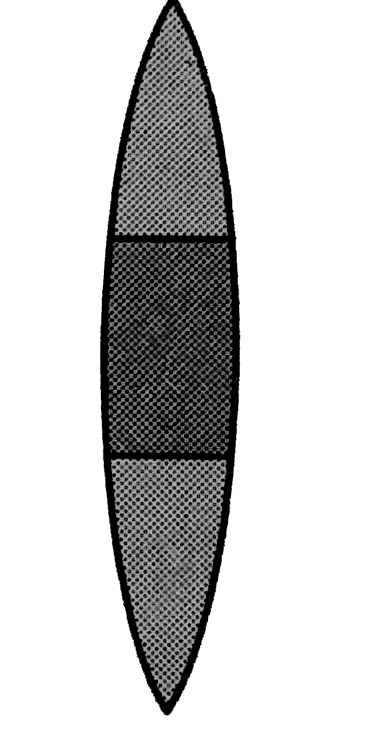 03:36View Solution
03:36View Solutionconsider three congerging lenses `L_1, L_2 and L_3` having identical geometrical construction. The index of refraction of `L_1 and L_2 are mu_1 and mu_2` respectively. The upper half of the lens `L_3` has a refractive index `mu_1` and the lower half has `mu_2`. A point object O is imaged at `O_1` by the lens `L_1 and at O_2` by the lens `L_2` placed in same position . If `L_2` is placed at the same place.
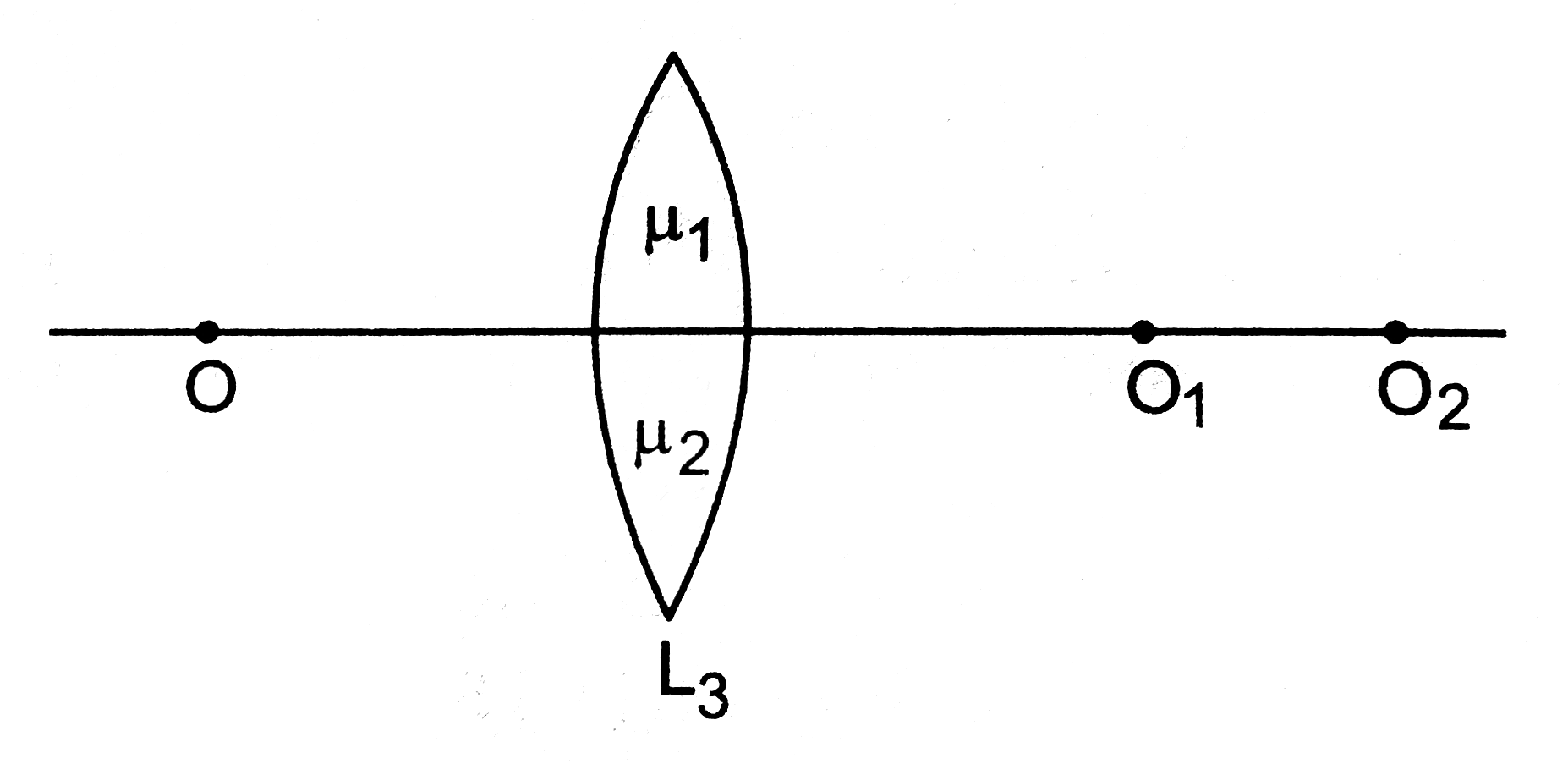 03:31View Solution
03:31View Solution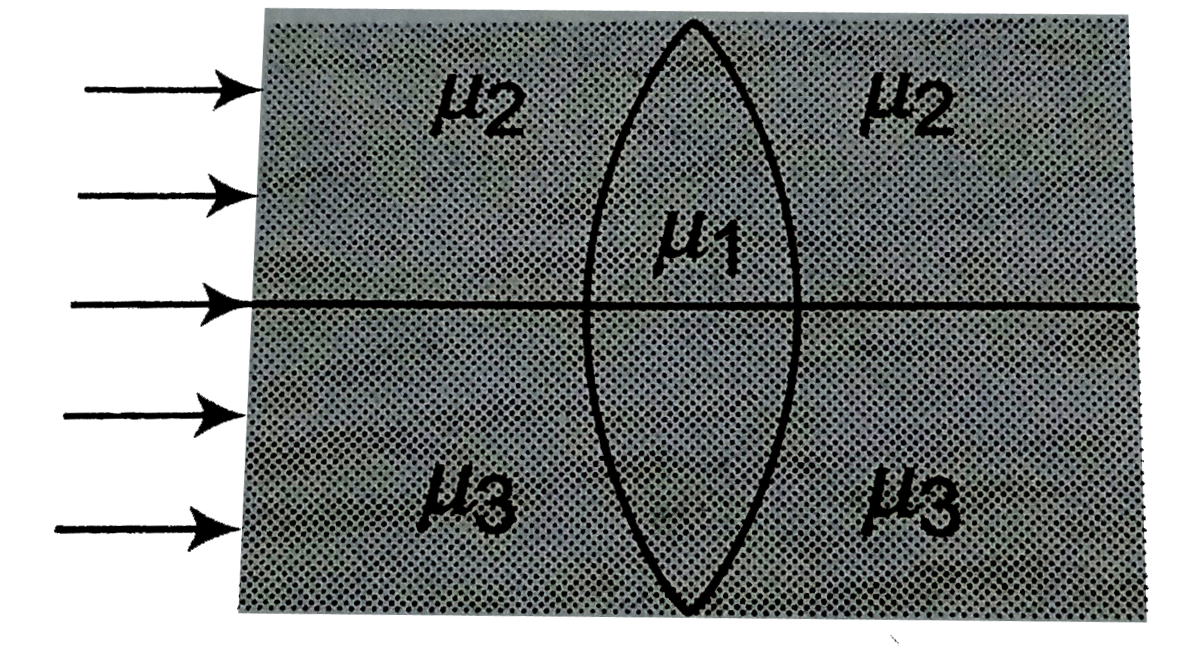
A double convex lens made of a material of refractive index `mu_1`, is placed inside two liquids of refractive indices `mu_2` and `mu_3` as shown `(mu_1gtmu_2gtmu_3)` A wide parallel beam of light is incident on the lens from the left. The lens will give rise to02:20View SolutionA parallel beam of light is incident on a converging lens parallel to its principal axis. As one moves away from the les on the other side on its principal axis, the intensity of light
02:29View SolutionA point source of light is placed at a distance of 2f from a converging lens of focal length f. The intensity onteh other side of the lens is maximum at a distance
01:56View SolutionA thin lens, made of glass of refractive index `3//2,` produces a real and magnified image of an object in air. If the whole system, maintaing the same distance between the object and the lens, is immersed in water `(RI=4//3),` then the image formed will be
04:00View Solution
A convex lens is used to form a real image of the object shown in the figure. The real inverted image shown in the following figures is02:11View SolutionA convex lens of focal length 16 cm forms a real image double the size of the object. The image distance of the object from the lens is
01:37View SolutionAn object 1.5 cm high is placed 10 cm from the optical centre of a thin lens. Its image is formed 25 cm from the optical centre on the same side of the lens as the object. The height of the image is
01:32View SolutionA needle of height 5 cm placed 45 cm from a lens forms an image on a screen placed 90 cm on the other side of the lens the type of lens and its focal length are
02:05View SolutionIn previous question, the nature and size of the image are
02:05View SolutionAn object is placed first at infinity and then at 20 cm from the object side focal plane of a convex lens. The two images thus formed are 5 cm apart the focal length of the lens is
02:38View SolutionThe focal length of convex tens is `f` and the distance of an object from the principal focus is x. The ratio of the size of the real image to the size of the object is
03:15View SolutionThe distance between an object and its real image formed by a lens is D. If the magnification is `m`, the focal length of the lens is
03:07View SolutionAn object is placed at a distance of 12 cm from a convex lens on its principal axis and a virtual image of certain size is formed. If the object is moved 8 cm away from the lens, a real image of the same size as that of the virtual image is formed. The focal length of the lens in cm is
04:22View SolutionWhen an object is moved along the axis is of a lens images three times the size, of the object are obtained when the object is at 16 cm and at 8 cm respectively from the lens. The focal length and nature of the lens are
02:07View SolutionThe distance between two point object P and Q is 32 cm, a convex lens of focal length 15 cm is palced bewteen them so that the images of both the objects are formed at the same place. The distance of P from the lens could be
(i) 20 cm
(ii) 18 cm
(iii) 16 cm
(iv) 12 cm04:47View SolutionAn image of a bright square is obtained on a screen with the aid of a convergent lens. The distance between the square and the lens is 40cm. The area of the image is nine times larger than that of the square. Select the correct statement(s):
05:00View SolutionA lens if placed between a source of light and a wall. It forms images of area` A_(1)` and `A_(2)` on the wall for its two different positions. The area of the source or light is
05:27View SolutionFigure given below shows a beam of light converging at point `P.` When a concave lens of focal length `16cm` is introduced in the path of the beam at a place `O` shown by dotted line such that `OP` becomes the axis of the lens, the beam converges at a distance `x` from the lens. The value `x` will be equal to
 04:03View Solution
04:03View SolutionA converging beam of rays in incident on a diverging lens. Having passed through the lens the rays intersect at a point `15 cm` from the lens. If the lens is removed, the point where the rays meet, move `5 cm` closer to the mounting that holds the lens. Find the focal length of the lens.
05:35View SolutionA cardsheet divided into squares each of size `1 mm^(2)` is being viewed at a distance of `9 cm` through a magnifying glass (a conerging lens of focal length `10 cm`) held close to the eye.
(a) What is the magnification produced by the lenas ? How much is the area of each square to the virtual image ?
(b) What is the angular magnification (magnifying power) of the lens ?
( c) Is the magnification in (a) equal to the magnifying power in (b) ? Explain05:49View SolutionRays of light from Sun falls on a biconvex lens of focal length f and the circular image of Sun of radius r is formed on the focal plane of the lens. Then
03:48View SolutionA boy is trying to start a fire by focusing sunlight on a piece of paper using an equiconvex lens of focal length `10cm`. The diameter of the sun is `1.39xx10^(9)m` and its mean distance from the earth is `1.5xx10^(11)m`. What is the diameter of the sun's image on the paper ?
03:46View SolutionThe distance between an object and its real image formed by a convex lens cannot be
05:00View SolutionA thin converging lens of focal length f is placed bewteen an obejct an a screen at a distance D apart, (displacement method)
03:40View SolutionIn the displacement method, a convex lens is placed in between an object and a screen if the magnification in the two position are `m_1` and `m_2(m_1gtm_2)` and the distance between the two positions of the lens is x, the focal length of the lens is
View SolutionThe distance between the object and the screen is d (greater than 4 times the focal length of a convex lens). Real images of the object are obtained on the screen for two positions of the lens that are separated by distance x apart. The ratio of size of the images in the two positions of the lens are
05:02View SolutionIn displacement method, the lengths of images in the two positions of the lens betwent the object and the screen are 9 cm and 4 cm respectively. The length of the object must be
01:16View SolutionThe distance between an object and the screen is 100cm. A lens produces an image on the screen when the lens is placed at either of the positions 40cm apart. The power of the lens is nearly
01:46View SolutionA screen is placed a distance 40 cm away from an illuminated object. A converging lens is palced between the source and the screen and it is attempted to form the image of the source on the screen. If no position could be found, the focal length of the lens
01:57View SolutionIn an experiment with a lens the object distance u versus image distance v data were obtained. Which of the following graphs will be linear? (Choose incorrect option)
02:47View SolutionThe graph between the object distance along the X-axis and image distance along Y-axis for a convex lens is
02:14View Solution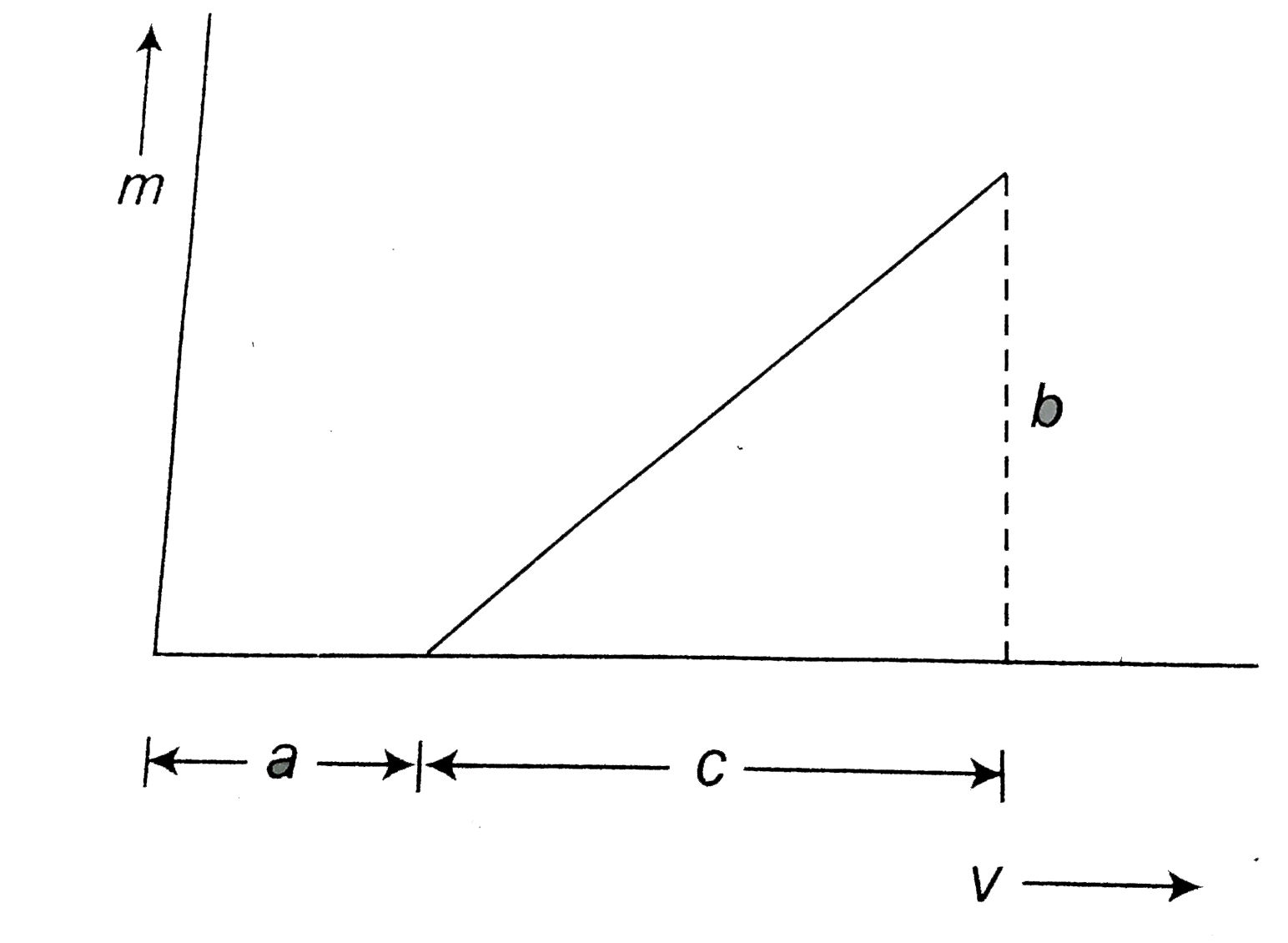
The graps shows the variation of magnification `m` produced by as convex lens with the image distance `v`. The focal length of the lens is02:04View SolutionIn an optics experiment, with the position of the object fixed, a student varies the postion of a convex lens and for each position, the screen is adjusted to get a clear image of the object. A graph between the object distance u and the image distance v, from th elens, is plotted using the same scale for the two axes. A straight line passing through the origin and making an angle `45^(@)` with the x-axis meets the experimental curve at P. The coordinated of P will be:
01:25View SolutionA student measures the focal length of a convex lens by putting an object pin at a distance `u` from the lens and measuring the distance `v` of the image pin. The graph between `u` and `v` plotted by the student should look like
02:04View SolutionThe graph between the lateral magnification `(m)` produced by a lens and the distance of the image `(v)` is given by
01:52View SolutionFor a convex lens, if real image is formed the graph between `(u+v)` and `u` or `v` is as follows
03:55View SolutionDiameter of a plano-convex lens is 6cm and thickness at the centre is 3mm. If speed of light in material of lens is `2xx10^(8)(m)/(s)`, The focal length of the lens is
03:48View SolutionAn object is placed at a distance `x_1` from the principal focus of a lens and its real image is formed at a distance `x_2` from the another principal focus. The focal length of the lens is
02:11View SolutionA point object `O` is placed on the principal axis of a convex lens of focal length `f=20cm` at a distance of 40 cm to the left of it. The diameter of the lens is 10. An eye is placed 60 cm to right of the lens and a distance `h` below the principal axis. The maximum value of `h` to see the image is
04:23View SolutionAn illuminated object is placed on the principal axis of a converging lens so the a real image is formed on the other side of the lens. If the object is shifted a little,
02:44View Solution
A split lens has its two parts separated by `a` and its focal length is `f`. An object is placed at a distance `(3f)/(2)` on the axis of undivided lens as shown. The distance between the virtual source is04:03View SolutionWhen a biconvex lens of glass having refractive index `1.47` is dipped in a liquid, it acts as a plane sheet of glass. This implies that the liquid must have refractive index.
03:37View SolutionA convex lens if in contact with concave lens. The magnitude of the ratio of their focal length is `(2)/(3)`. Their equivalent focal length is 30 cm. What are their individual focal lengths?
02:36View Solution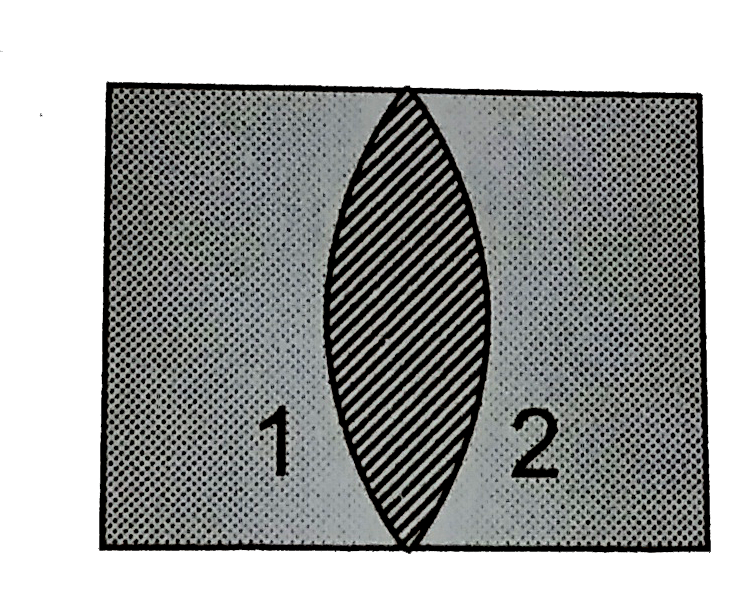
Two plano-concave lenses (1 and 2) of glass of refractive index 1.5 have radii of curvature 25 cm and 20 cm. They are placed in contact with their curved surface towards each other and the space betweent hem is filled with liquid of refractive index `(4)/(3)` the the combination is06:10View SolutionTwo similar planoconvex lenses are combined together in three different ways as shown in the adjoining figure. The ratio of the focal lengths in three cases will be
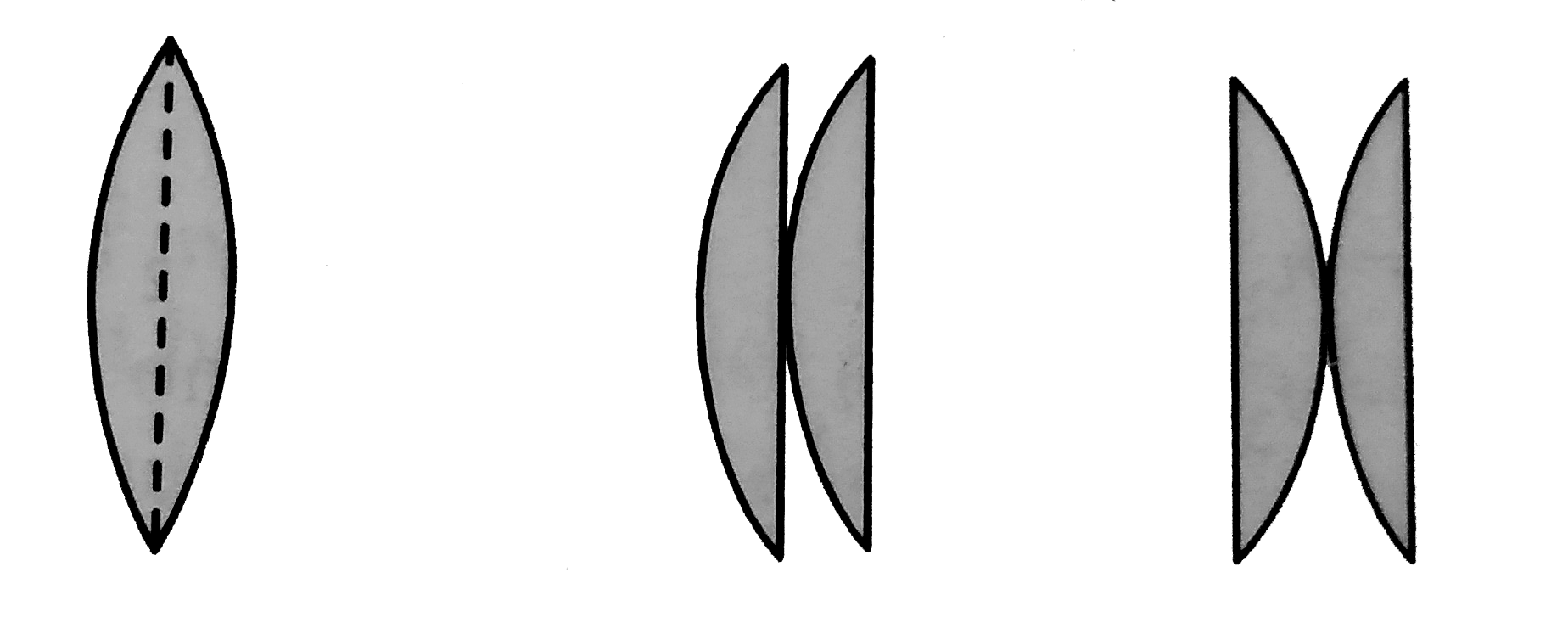 01:58View Solution
01:58View SolutionA convex lens of focal length 40 cm a concave lens of focal length 40 and a concave lens of focal length 15 cm are placed in contact. The power of this combination of are placed in contact. The power of this combination in diopters is
02:04View SolutionTwo thin lenses of powers `2D` and `3D` are placed in contact. An object is placed at a distance of 30 cm from the combination The distance in cm of the image from the combination is
01:57View SolutionA real image is formed by a convex lens. If we put a concave lens in contact with it, the combination again forms a real image. The new image
03:05View SolutionA beam of parallel rays is brought to focus by a planoconvex lens. A thin Concave lens of the same focal length is joined to the first lens. The effect of this is
02:29View SolutionA concave lens and a convex lens have same focal length of `20 cm` and both put in contact this combination is used to view an object `5 cm` long kept at `20 cm` from the lens combination. As compared to object the image will be
03:28View SolutionA bi-convex lens is formed with two thin plano-convex lenses as shown in the figure. Refractive index n of the first lens is 1.5 and that of the second lens is 1.2. Both the curved surface are of the same radius of curvature R=14 cm. For this bi-convex lens, for an object distance of 40 cm, the image distance will be `
 04:28View Solution
04:28View SolutionThe size of the image of an object, which is at infinity, as formed by a convex lens of focal length 30 cm is 2 cm. If a concave lens of focal length 20 cm is placed between the convex lens and the image at a distance of 26 cm from the convex lens, calculate the new size of the image
04:52View SolutionChoose the correct option regarding lenses in contact.
02:13View SolutionA paralel beam of light incident on a concave lens of focal length 10 cm emerges as a parallel beam from a convex lens placed coaxially, the distance between the lenses being 10 cm. The focal length of the convex lens in cm is
02:23View SolutionA convex lens A of focal length `20 cm` and a concave lens B of focal length `5 cm` are kept along the same axis with a distance d between them. If a parallel beam of light falling on A and B as a parallel beam, then d is equal to ……cm
04:25View SolutionTwo convex lenses of focal length `f_1` and `f_2` are mounted coaxially separated by a distance. If the power of the combination is zero, the distance between the lenses is
02:03View SolutionA combination of two thin lenses with focal lengths `f_(1)` and `f_(2)` respectively forms and image of distant object at distance `60cm` when lenses are in contact. The position of this image shifts by `30 cm` towards the combination when two lenses are separated by `10 cm`. The corresponding values of `f_(1)` and `f_(2)` are
05:08View Solution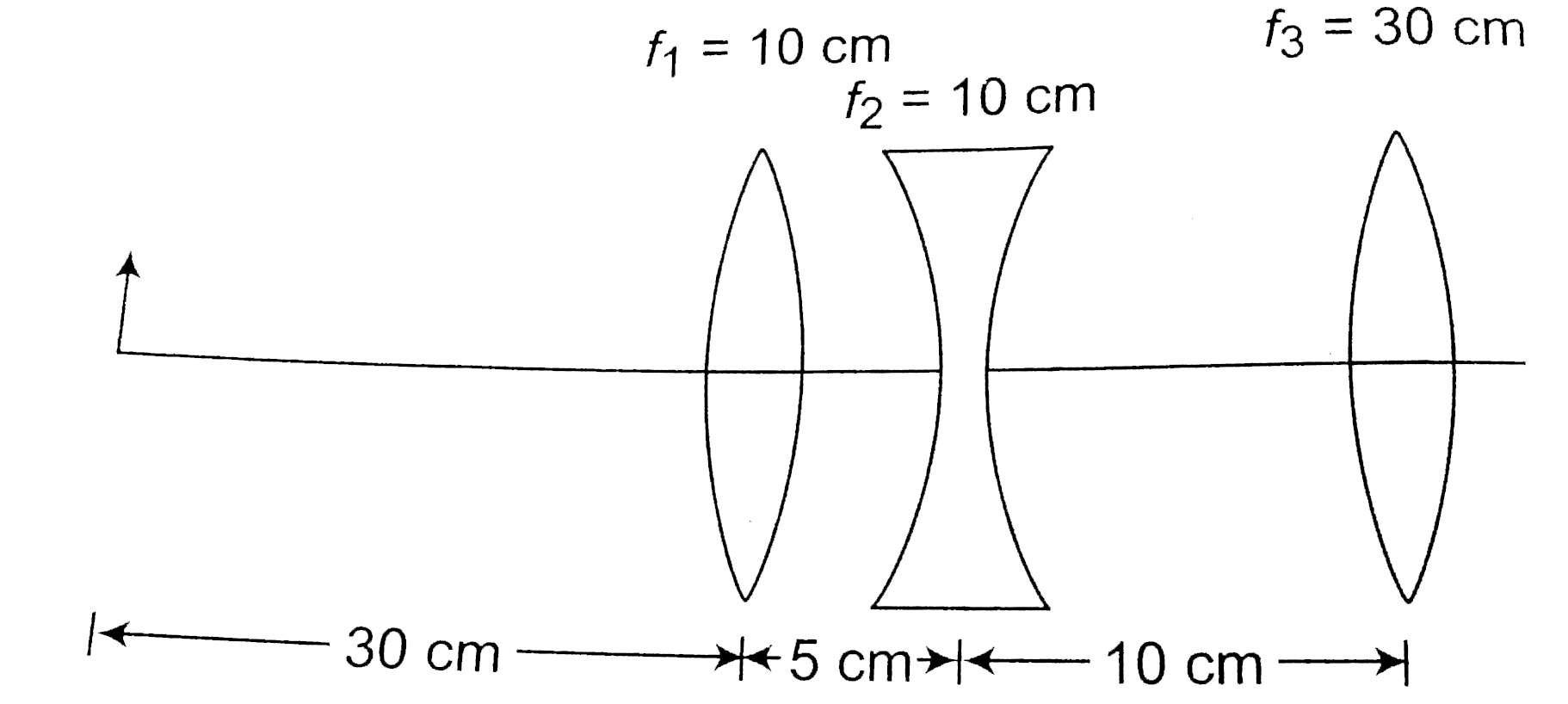
The position of fical image formed by the given lens combination from the third lens will be at a distance of `f_1=+10cm,f_2=-10cm,f_3=+30`05:07View SolutionAn object is placed `12 cm` to the left of a converging lens of focal length `8cm`. Another converging lens of `6 cm` focal lengh is placed at a distance of `30 cm` to the right of the first lens. The second lens will produce
04:20View SolutionA converging lens forms a real image `I` on its optic axis. A rectangular galss slab of refractive index `mu` and thickness `t` is introduced between the lens and `I`. `I` will move
02:25View SolutionA lens forms a sharp image on a screen. On inserting a parallel sided glass slab between the lens and the screen, it is found necessary to move the screen a distance `d` away the lens in order for the image to be sharp again. If the refractive index of the material of the slab is `mu`, the thickness of the slab is
02:59View Solution
A real image of an object is formed by a conex lens at the bottom of an empty beaker. The beaker is now filled with a liquid of refractive index 1.4 to a depth of 7 cm. In order to get the image again at the bottom the beaker shoud be moved02:03View SolutionA concave mirrorr of focal length `f_(1)` is placed at a distance of `d` from a convex lens of focal length `f_(2)`. A beam of light coming from infinity and falling on this convex lens-concave mirrorr combination returns to infinity. The distance `d` must equal.
04:17View SolutionA concave lens of focal length 20 cm placed in contact with ah plane mirror acts as a convex mirror of focal length
01:52View Solution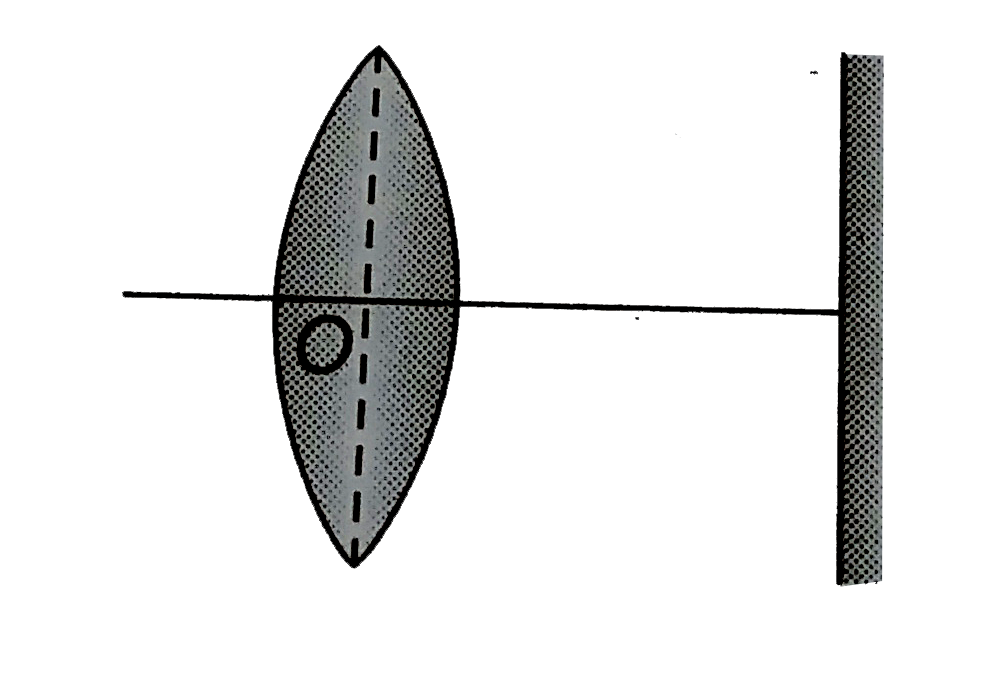
The distance between a convex lens and a plane mirror is 10 cm. The parallel rays incident on the convex lens after reflection from the mirror forms image at the potical centre of the lens. Focal length of lens will be02:30View SolutionA luminous object is placed at a distance of 30 cm from the convex lens, of focal length 20 cm. On the other side of the lens, at what distance from thelens a convex mirror of radius of curvature 10 cm be placed in order to have an image of the object coincident with it
03:15View SolutionAn object is placed at 15 cm from a convex lens of focal length 10 cm. Where should another convex mirror of radius 12 cm placed such that image will coincide with object.
02:54View SolutionA convex lens of focal length 40cm is held at a distance 12cm coaxially above a concave mirror of focale length 18cm.
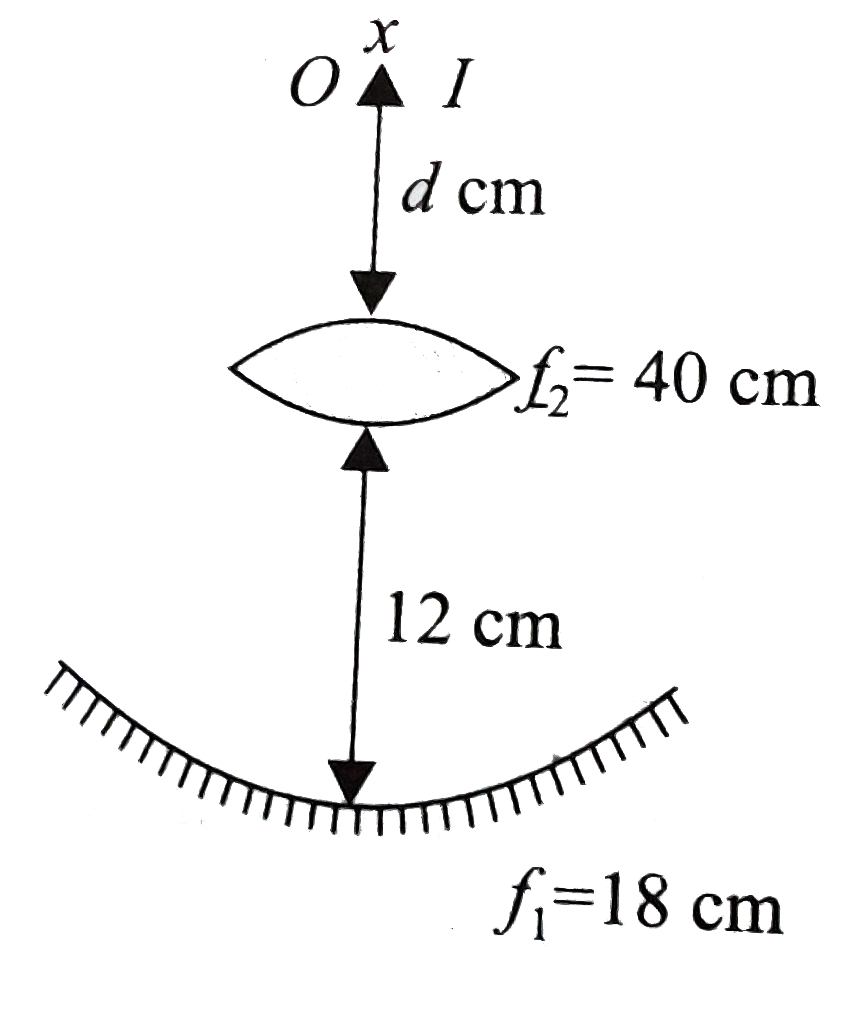
Q. A luminous point object placed d cm above the lens on its axis gives rise to an imag coincident iwth itself, then the value of d is equal to02:25View SolutionThe focal length of a plano-convex lens is `f` and its refractive index is 1.5 it is kept over a plane galss plate with its curved surface touching the glass plate. The gap between the lens and the glass plate is filled by a liquid. As a result the effective focal length of the combination becomes `2f`. Then the refractive index of the liquid is
04:19View SolutionAn equi-convex lens, having radius of curvature 33 cm is placed on a horizontal plane mirror and a pin held 20 cm above the lens coincides with its image. Now the space between the and the mirror is filled with a liquid in order to coicide with the image the pin has to be raised by 5 cm. The refractive index of the liquid is
03:59View SolutionA convex lens of focal length 15 cm is placed on a plane mirror. An object is placed 20 cm from the lens. The image is formed
04:18View Solution
EXERCISES questions and complete solutions for chapter REFRACTION AT SPHERICAL SURFACES of CP SINGH PHYSICS (HINGLISH) of Class 12
